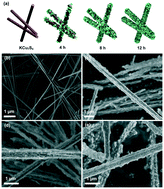Controllable crystal growth of a NiCo-LDH nanostructure anchored onto KCu7S4 nanowires via a facile solvothermal method for supercapacitor application†
Abstract
The application of NiCo-LDHs as electrode materials for supercapacitors has attracted widespread attention. However, pristine NiCo-LDHs always suffer from low conductivity and instability that limit their electrochemical performance in supercapacitors. Herein, we rationally engineered a novel KCu7S4@NiCo-LDH core–shell structure with good capacitive performance using a simple one-step solvothermal method and applied this structure as an electrode material for supercapacitors. KCu7S4 nanowires act as a dependable “skeleton” for supporting the NiCo-LDH nanosheets, thus preventing the aggregation of NiCo-LDHs and improving their conductivity. By controlling the reaction time and the ratio of Ni/Co in the precursor solution, according to the results of electrochemical testing, an optimal composite was obtained with Ni/Co = 2/1 and the reaction time of 8 h; the final KCu7S4@Ni2Co1-LDH composite possessed the high specific capacitance of 1104.5 F g−1 (122.7 mA h g−1) at 2 A g−1, good rate capability of 65.9% when the current density reached up to 10 A g−1, and a long-term stability (an 83.5% capacitance retention after 1000 cycles).

- This article is part of the themed collection: Crystal engineering for electrochemical applications


 Please wait while we load your content...
Please wait while we load your content...